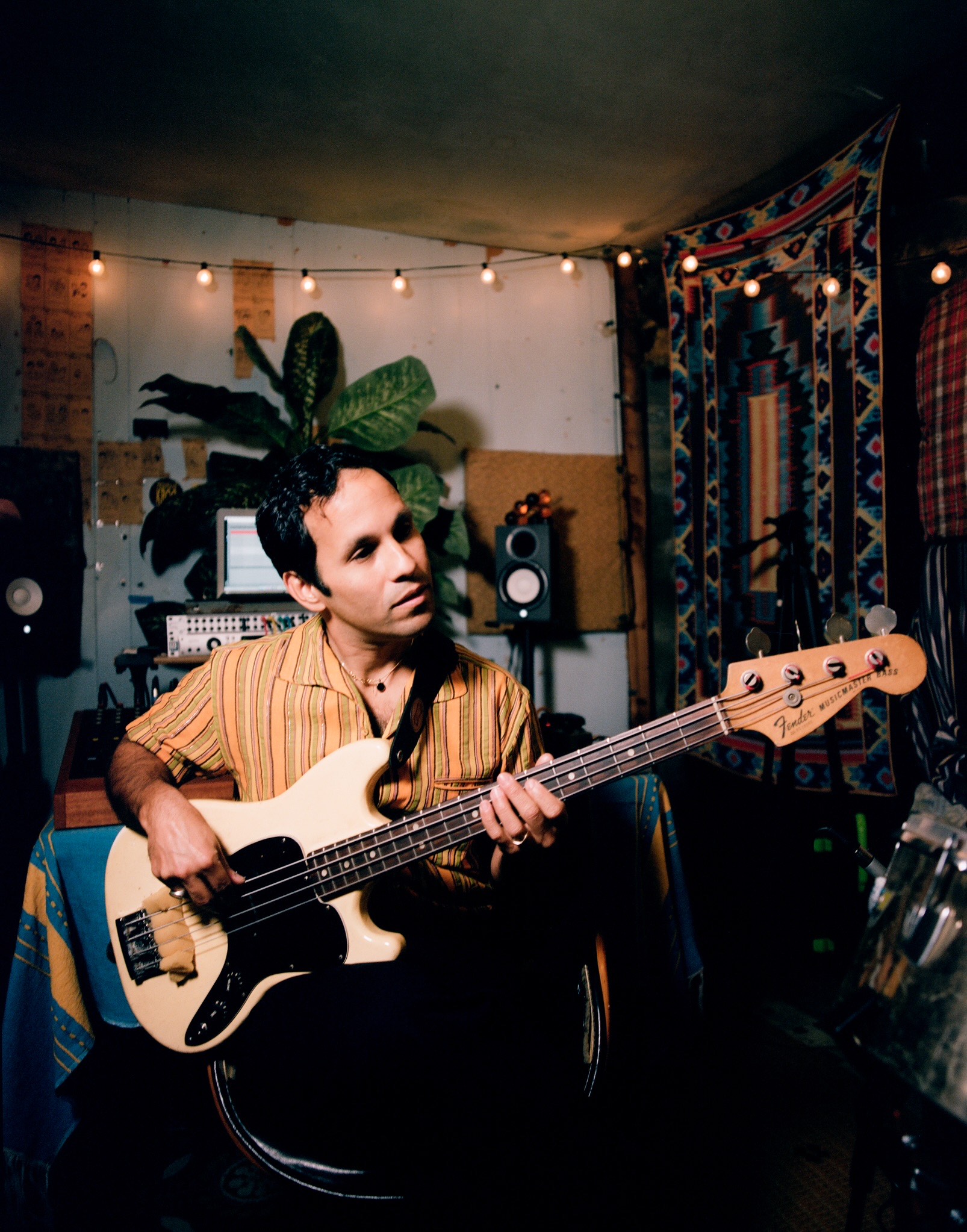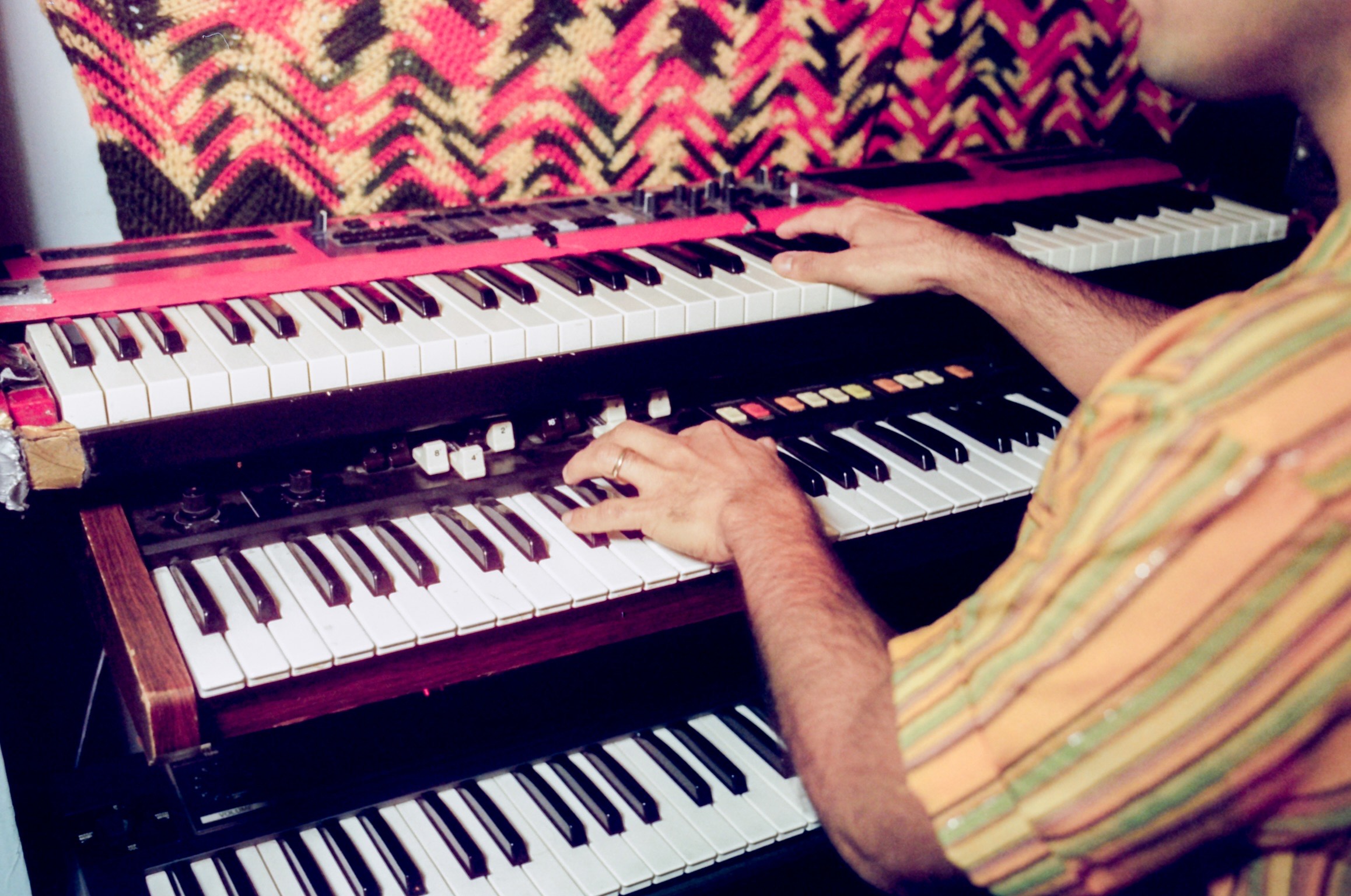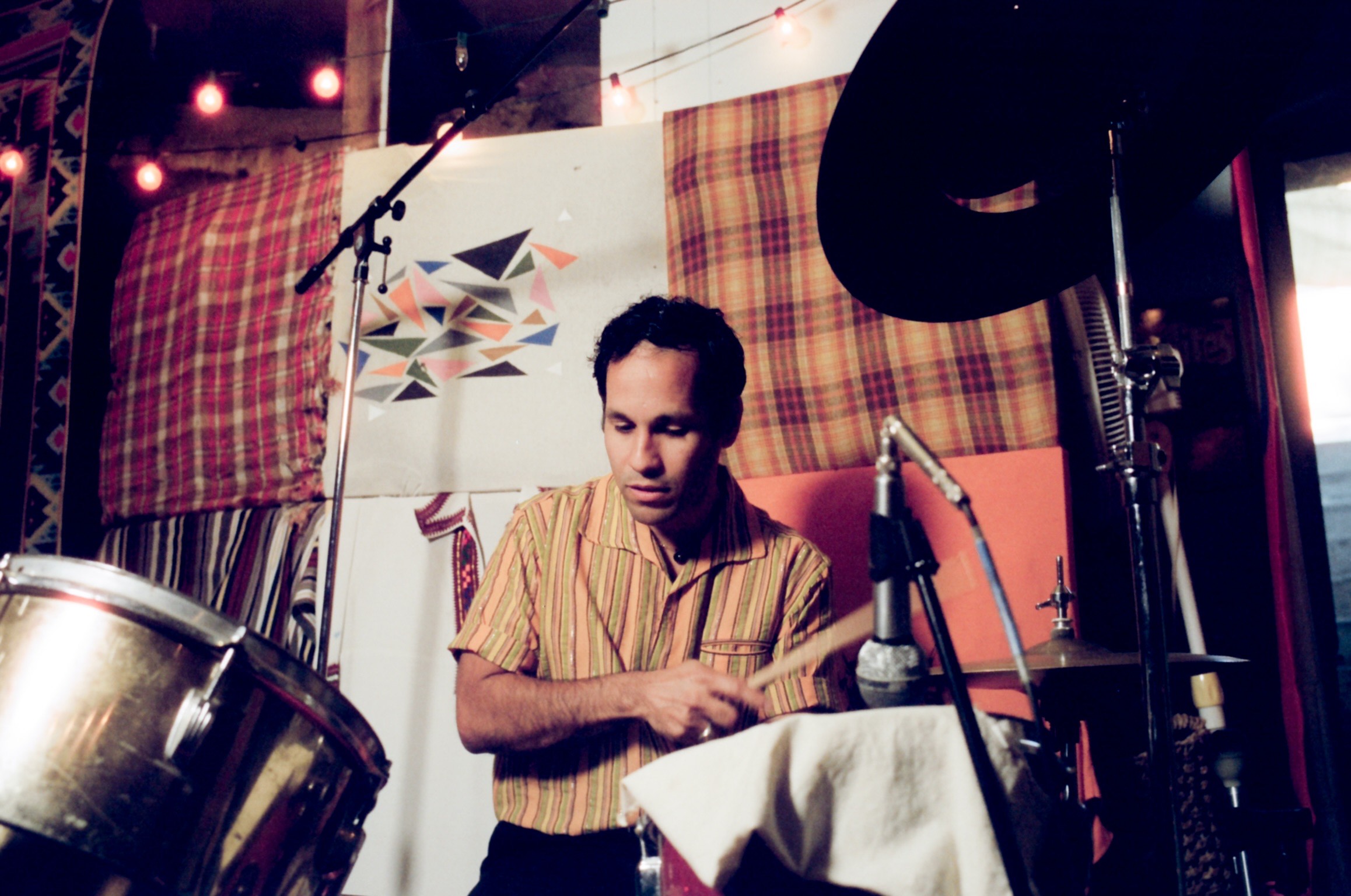
Time and space—they're invaluable assets for musicians, both often in short supply. Finding a creative enclave to write, record, and experiment not only promotes a DIY sense of self-efficacy, but it also removes the barrier to one particularly challenging aspect of songwriting: getting started. For Puerto Rican singer, songwriter, and multi-instrumentalist Pachy García, investing in his home studio in Los Angeles directly parallels his growth as an engineer and composer.
García built 333 House in 2019, slowly and with intention, recording and releasing his debut LP as Pacyhman that same year. Garcia's forward-thinking take on dub and roots reggae is equal parts unorthodox and accessible. As a multi-instrumentalist, he's acutely aware that music is an invitation to listen, think, pause and connect. Ahead of the release of Switched On, his fourth studio LP recorded entirely at home, Garica spoke with us about developing his ear, providing context to listeners, and when to look for feedback.
Give me some background on your studio, the 333 House.
333 House got its name in 2019. I had recently acquired a Gretsch Catalina Bop kit from a friend of mine. My roommate said, "You're not going to put that in the house, right?" I'm like, "Where else would I put it?" She suggested the basement that no one uses. I was like, "If you're giving me the green light to turn the basement into a drum room, I'll take it." That's how the whole thing started.
What were you capturing sounds with early on?
I got a Tascam 388 around 2014. I was touring with a reggae band called The Expanders that recorded a lot of their records on the 388. I'm like, "Damn, that sounds authentic." I discovered that Ty Segall and John Dwyer both used one to record a bunch of Thee Oh Sees catalog and those first Ty Segall records. And Tim Presley from White Fence. I was like, "Oh man, this machine is magical. I had it for a long time and recorded my old band on it. At the time I understood that engineering was not for me.
When I got into my basement and brought my drum kit down, I also brought the 388. I wanted to start using it again to learn how to record and produce my own music. I was disheartened from going into beautiful studios with vintage gear and not getting the sound I wanted. I was ready to try my hand at producing and getting tones. I went through a vaporwave phase producing beats. I always wanted to recreate that old Jamaican, Channel One Studios sound.
I had the drum kit, 388, and some cheap old microphones I acquired at thrift stores. I started getting into the nitty gritty, recording my own tones, and eventually started to figure out what I was doing. I recorded to Ableton Live, so a lot of it was a hybrid approach. It was digital, then I would dump it into tape. I would mix from tape through the 388 back into Ableton Live. I started getting my own little Channel One sound, like Scientist and The Roots Radics Band. That King Tubby vibe. I also started making videos on Instagram and those took off.
I invited a friend over who's a trombonist and recorded a super heavy, rootsy, Augustus Pablo Rockers at King Tubby-inspired album.That was when I baptized the name of the studio, 333 House.
What gear is essential to the Pachyman sound?
My ‘67 Ludwig Supraphonic snare, my Zildjian New Beats hi-hats from '72, and my Fender Musicmaster bass from ‘75. Those are three components that make it to all of my recordings, pieces I would never leave.
How did having a dedicated creative space impact your process?
Just getting in there and trying to emulate certain sounds—having time to learn how to use EQs, compression, and how to set up mics. Learning how to play in a studio setting rather than live gave me so much insight. Having this space was solid because I had cheap equipment that didn't work well, but I had enough. I had time to figure out what was missing for me at other studios. I'd never been a producer. In the bands I've been in it was more of a democratic state where everyone has an opinion about the mix.
With it being just me, I could zone in on things I've never been able to. Drum tones, bass tones, experimenting with cutting the highs—which I've always been curious about, but engineers tend to be against. I understand why now, but at the beginning I wanted to know how cutting highs, working with mid/low mids worked in a production.
It’s amazing how much time and space can impact creative people.
Absolutely. Not everybody can afford to be in a studio for extended periods of time. There is an argument for having little time to work on a piece. That's cool, but I never had the opportunity to take my time on one song - to take a week on a song instead of having to go into a studio, record a whole record in two or three days.
What early experiences in music helped build a foundation?
Without my interest in music and starting at a young age, I wouldn't be able to get where I'm at. I learned how to play four instruments that are the foundation of what I do. When I learned how to play drums, the last instrument I learned, that’s when I could work on my own records without needing anyone. Working with what I had.
It all started with tracking drums into Ableton, everything close mic’d, bass, then I would write over it. Keyboards, organs and guitars. Organs and keyboards in reggae were my forte.
I went to school and studied piano. In Puerto Rico I gigged for 10 years playing keyboards in reggae bands. That part of the process was taken care of, I had done the legwork back when I was younger. The beauty of it is that my favorite tracks in reggae and that surrounding world were minimal in those instruments. I didn't have to worry too much about that. I had to lay down a solid drum and bass foundation.

What’s your current keys set up?
I acquired a Hammond M3—kind of the poor man’s B3. They were cheap back in the day. Found it at a thrift store. A lot of my organ work on the records comes from the Hammond. I also have a Korg Poly 800. I wrote a lot of the new record Switched On using that keyboard. Those are the main focus. I mostly do leads on a Roland SH01-A, which is the clone of the SH-10, one of my favorite synthesizers because I grew up obsessed with Aphex Twin and Boards of Canada. To this day I'm a Boards of Canada obsessive. I wanted to find a way to implement those sonic characteristics into music that is raw and roots based.
Has your approach to tracking drums changed over the years?
I learned to play drums with my other band, Prettiest Eyes, a synth-punk outfit on Castle Face Records that toured a lot with loud bands including Thee Oh Sees. The biggest takeaway I learned during this process is recording quietly - a huge game changer. The first couple of Pachyman records I was playing as loud as I was with Prettiest Eyes, hammering on the snare, which goes hand in hand with how Style Scott, the drummer of Roots Radics, played. He was a loud drummer firm, solid, kind of the Buddy Rich of reggae. Little by little I noticed how much I could find different sounds on drums by turning the mics way hot and playing quiet. That's kind of the Sly and Robbie school of recording as well. Quiet players recording close to the mic and really hot.
How often are you changing your workflow?
I’m a big fan of having everything set up in advance. That being said, I do think it’s important to move stuff around and experiment. I love being able to get to a station and write on that station where everything is staged for the most part. Most of my studio is set up that way. I move a ribbon microphone around the room a lot when it comes to drum tracking. I've been experimenting with using a ribbon mic as opposed to a dynamic for guitars.
I recorded so much for three years straight so I figured out a sound. Now I can achieve that sound by going to my stations and playing. I know exactly how it is going to sound and I'm cool with that. If I want to get away from that, I have to start moving stuff. It’s a process that never stops. You're constantly learning.
When do you look for feedback given so much of your work is solitary?
I’ve always been open to feedback. My wife gives me a lot of feedback when I'm like, "Is this cringe? Please tell me." We've been together a long time - she grew up with me, playing in all those reggae bands. She has more knowledge of reggae music than anyone else I know. Apart from her I have amazing friends who are artists. I trust their taste so I'm always asking, what do you think of this? Any ideas? A lot of my breakthrough ideas have been things my friends suggested. I'm very open, but you have to know yourself more than anybody.
What techniques do you implement for using voice as a texture rather than lead instrument?
A lot of trial and error. I recorded vocals on the record for the next single where I put up a ribbon mic far away. I was screaming from the other side of the room. It feels like you're in a big room playing with a lot of people or outside in the street. That gave it this weird sensation of feeling like I'm in the streets of Puerto Rico vibing to the song.
When performing live you give audience members plenty of context re: your process. What impact does this have on your relationship with them?
That came out of necessity. I was practicing a lot before touring when The Return Of came out. I remember explaining it in the studio to myself first. I think I did it at Desert Days for the first time. The feedback from that moment was big, I could see it clicking with people. Afterward a lot of people came up to me and said I loved how you explained what you’re doing. I figured this has to be written into the shows. I did it for a year and a half to the point where I'm burnt on explaining it because it can feel like a gimmick or a bit. At the same time, every time I do it, I'm inviting the audience member to be a part of it. It can be hard to understand what I'm doing on stage. I'm moving my hands, I'm pressing a lot of buttons.

What’s your live setup?
I started bringing the 388 to shows, that was insane. So heavy with the tape. Then I got a smaller Tascam, the M208 and a Fostex M80, an upright quarter-inch, eight-channel reel to reel, for the purpose of playing live. I liked that machine so much that it became my main one. It was so clean and crisp that I was like, oh dude, this is my tape machine now for the studio. That's where I recorded The Return Of. After it came out, I bought an even smaller Tascam—the M106—because it fits on a Pelican case. I knew I could travel with it, checking it on the plane. I decided to go for a computer with Ableton Live, which is what I'm used to, going through the M106. I still have my Roland SH-01, which travels with me everywhere.
I muted all the leads on my sessions and I played them live. I have a Nord Electro 2 that I've had for 20 years. It came with me from Puerto Rico. It's the Tascam, the Nord Electro 2 and the SH-01. Obviously my Boss Space Echo, the RE-20. Also a Holy Grail. That's been my reverb ever since I started the project.
What factors have helped you to develop your ear?
Listening to music and kind of staying curious. I've always been curious about experimental music in general and have always tried to not keep myself tied down to a genre. I'm very anti-genre in that sense. Good music is good music regardless of how it's categorized. Listening to music that inspires you, tone-wise or composition-wise, are key elements to develop your sound. Ultimately we grab things from the wild that we like and we filter, process them then spit them back out. That's what keeps me evolving. Finding work you like - mimicking it for a bit to find how it works. Doing cover songs is an insightful way to understand how songs are made. It's crazy how simple an effective idea can be.
When writing you'll start with harmonic or melodic elements but those are removed at the end. Does that leave with you a bank of ideas that you might come back to?
For sure. It's crucial for those songs. If you're going into the foundation of what I started doing, which was this Jamaican style, you need the song to be incredibly solid before you start eliminating things. They didn't write just drums and bass and then guitars and pianos were an afterthought.
I’d imagine that's a big misconception of that music as a whole.
Yes, absolutely. The same way it’s a misconception that it has to be related to weed in some way. I get it, but most of these musicians and engineers were sober for the exception of Lee Scratch Perry, but they're in the room fucking around with technology they had available at the time - it was groundbreaking. It's the first time where music made engineers the artists.
Is there anything else that we haven't covered that you want to touch on?
It’s funny–I'm being interviewed by Reverb but something I'm adamant about is that so much of this doesn't have to do with gear. Gear is something that helps you, for sure. Don't get me wrong, I’m happy that I invested fucking $3,000 on Apollo, but that's not going to make your record good. It's about how you work with music and develop ideas, keep developing them and throw them away and start something new. It's about listening more than anything.
